5. Planet of the Dinosaurs (1977)
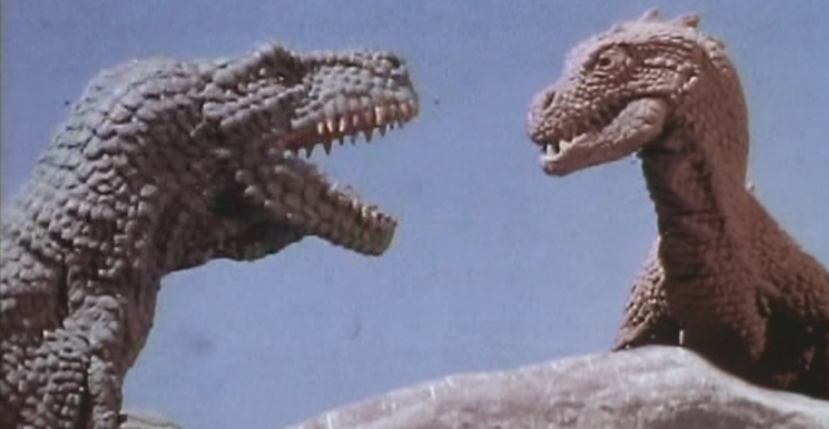
It’s “Star Wars” meets “Jurassic Park” and it’s sort of shocking that Hollywood hasn’t made a big budget remake and marketed it just like that.
The passengers and crew of a commercial space liner are stranded on an uncharted planet after their reactor goes critical. It doesn’t take them long to discover that their new home is ruled by dinosaurs who see them as lunch. The first night they hear a thundering growl off in the distance as a crewman intones, “Whatever it is it’s carnivorous and very, very hungry.” He’s exactly right. The cast, who mostly look like their day job was making porn films with Dirk Diggler out in the Valley, are eaten one-by-one while seeking higher ground where they hope large carnivores won’t be waiting for them. But not only is a T-Rex there, so is a giant spider! And as humans will do, even in the face of impending death by giant reptile, they begin fighting amongst themselves. The captain (Louie Lawless), who wants to play it safe as they await rescue, tries to maintain control while being challenged by his engineer (James Whitworth), who wants to kick some saurian butt. Should they keep running or hunt down the biggest, baddest dinosaur of them all and show them who’s boss?
The dino is finally dispatched and the five survivors build a stone home by the lake and start having babies. Even if they are never rescued, life goes on and they have a whole new world to tame.
“Planet of the Dinosaurs” is engaging if you give in and enjoy the cheesy ‘70s vibe, thick as burnt orange shag carpet. Other low-budget efforts from the era like “Dark Star” are just as dated and still get all the attention. But “Planet of the Dinosaurs” moves faster. Yes, the attempts at humor, mostly centered around the stereotypical obnoxious business executive (Harvey Shain), fall terribly flat and when the dialogue does get serious, and attempts are made at pondering the deep meaning and ramifications of being stranded light years from civilization, it does get silly. But the inevitable death of said obnoxious businessman, impaled on the horn of a dinosaur and dumped off a cliff, is satisfying.
And that’s why this film works. It knows exactly what it is. You don’t watch a movie with a title like this for enlightenment, you want cool stop motion dinosaurs, blood, and maybe a little sex. You get it all. The latter is mostly supplied (without any real nudity) by Derna (Derna Wylde) the “secretary” of the obnoxious businessman, who chose to make an interstellar voyage in the widest, grooviest hip-hugging bellbottoms that lace up the side you’ve ever seen. And by the navigator Chuck (Chuck Pennington) the big guy who’s been working out. He takes his shirt off in the first few minutes and never puts it back on again.
Keep an eye out for the instrument panel of the spaceship which looks to be constructed from an 8 Track player and early microwave. The double-knit polyester space uniforms are obviously modeled on those sported by Barbra Bain and Martin Landau in Space:1999 except in more chocolate shades of brown, more golden hues of yellow and more drab shades of off-white. The interesting synthesizer soundtrack is better suited to a straight up horror film but works nicely.
4. Attack of the 50 Foot Woman (1958)
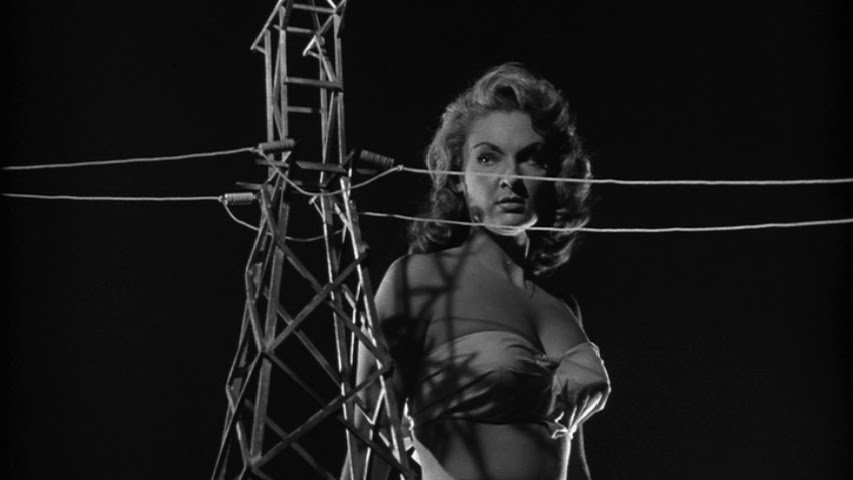
So many films with sensational titles can never live up to them (see “Nude for Satan”) but this one does. We get a 50 foot(ish) woman, and boy does she attack!
Nancy Archer (Allson Hayes) is an unstable and spoiled woman, born to great wealth, who has a drinking problem and a gold-digging cad for a husband, Harry (William Hudson). He’s carrying on with the town floosy, Honey Parker (Yvette Vickers) and everyone know it. Including Nancy.
Nancy also has the biggest diamond necklace you’ve ever seen. It puts the Hope Diamond to shame, yet she wears it casually for late night drives thorough the desert. There, on a long, lonely road, she encounters a giant glowing orb which lands in her path, running her off the road. A bald-headed giant, inexplicably wearing a tunic with a fleur-de-lys-covered shield on it, emerges and tries to take the gem right off of Nancy’s throat. She escapes and returns to her Harry, hysterical and ranting about a “satellite” and an alien colossus. The film was produced right after the launch of Sputnik shocked the world and “satellite” was the hottest most futuristic word since “atom” hit the mainstream in the summer of 1945. So, they use it, instead of the correct word “spaceship,” over and over here.
No one believes her, dismissing the wild stories as another bout of mental illness and drunkenness. But Harry sees an opportunity. He agrees to go with her back into the desert to look for this “satellite” but if they do not find anything she must agree to go back to the mental hospital. She agrees and Harry is sure he’s on his way to having poor Nancy committed and taking all of her money. Instead, they find the “satellite” and the giant. And Harry leaves her there.
Found and returned home, Nancy begins to grow, perhaps due to some radiation left by the giant alien when he finally did snatch her necklace. Doctors with restraints and giant hypodermic needles are called, but Nancy isn’t having any of it. She breaks free and lumbers into town, her clothing reduced to nothing more than a skimpy bikini on her now colossal frame. Bellowing “Harry” (become a quotable single world movie line) she finds him dancing with Honey. She rips the roof off the joint, tosses a beam smashing Honey to death, and grabs her unfaithful husband up in one giant paw. As she runs from the police, she gets tangled up in power lines and is electrocuted with Harry still in her clutches. The final line is delivered by the town sheriff (George Douglas) as he stands by their corpses, “She finally got Harry all to herself.”
This one didn’t win any Oscars, and it shouldn’t have. The special effects are not groundbreaking. The film is the butt of many jokes. But it doesn’t pretend to be anything other than what it is, 65 minutes of drive-in fun! The whole thing has got character. And it’s also known for having one of the very best movie posters in film history!
3. Midnight Movie Massacre aka Attack from Mars (1989)
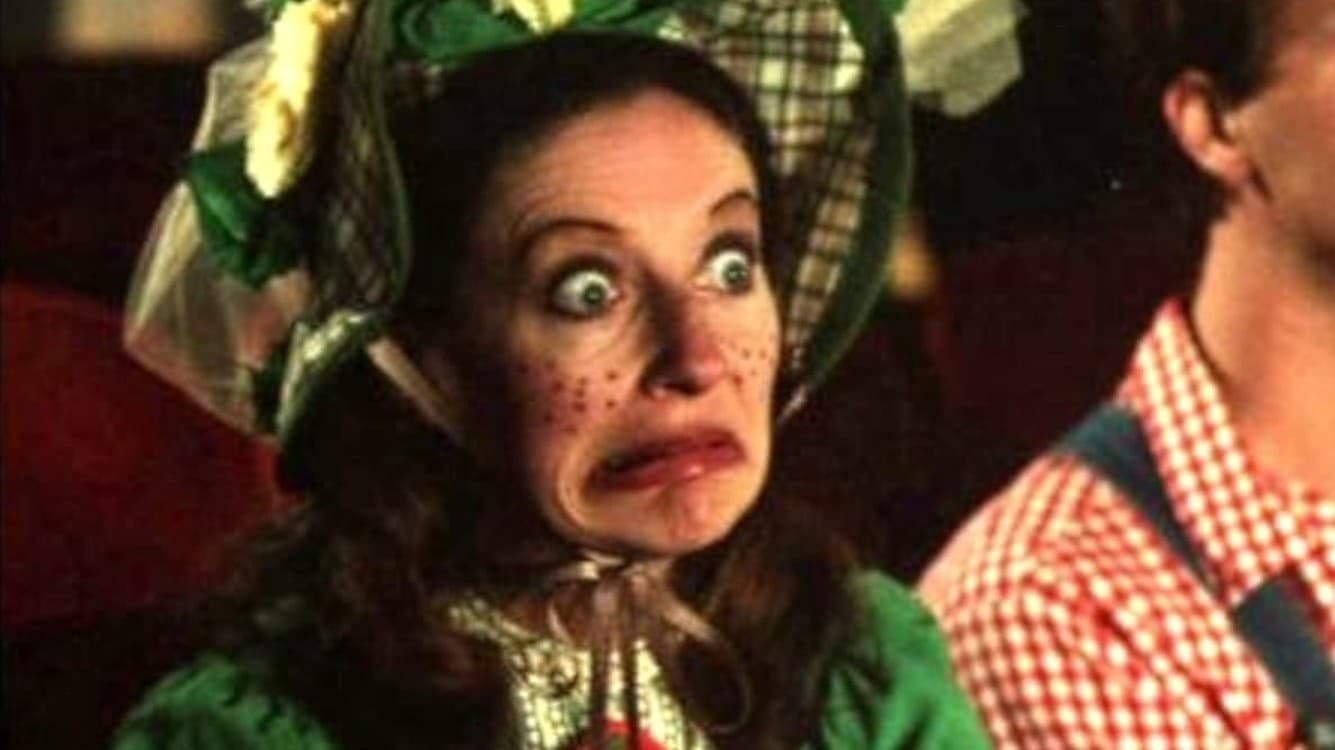
The patrons of a Southern California movie theater in the 1950s make out, hookup, overeat, and watch the Sci-Fi serial “Space Patrol” as a real alien with a taste for human flesh attacks. Played entirely for laughs, some of which miss terribly, it has impressive production values for what is obviously a low budget film and some genuinely good lines. Most of which are not politically correct these days (then what is!).
The characters at the theater are a mixed bunch. We’ve got two nerds (Vince Cabrera and David Lee Kious), one eager for the sci-fi spectacle and the other obsessed with the voluptuous actress (Tamara Sue Hill) in the poster for the upcoming feature, “Sweater Girls from Mars.” A guy on a date with a girl with huge breasts (Lori Davis). Three horny young vandals drawn to her mammoth attractions. A nebbish (Stuart Allen) on a date with an overweight, over-make-upped woman (the drag queen with the perfect name, Charity Case) who eats everything in the concession stand and is still hungry. A lanky cowboy (Brad Bittiker) doing his best to get his pretty young date (Susan Murphy) drunk. Again, politically incorrect, and long before #MeToo. And a few characters much better left on the cutting room floor (even if it had reduced the film barely an hour) like the girl with the runny nose and the rube couple who hookup with the hobo.
The serial they are all supposed to be watching is where the money went. It’s got spaceships, an entire army of robots, racing vintage cars, a Bond-like lair for the villain, and brains under glass domes like in the original Star Trek. This episode of the serial is entitled “Back From the Future” (it was made in the 1980s) and it has some handsome heroes and a beautiful heroine being sent back in time by Dr. Sylvia Van Buren (Ann Robinson of “The War of the Worlds!”) to find an evil scientist. There they encounter a genuine square jawed, well-muscled International Male model (John Kelly) whose clothes they need to take so they can fit into the 1950s, one of those kids in Sci-Fi films who saves the day, and a stripper named Tonga.
The serial ends in a cliffhanger, and in the real world the alien eats its way through the most of the movie house’s staff and audience before becoming dinner itself. It’s all far more charming than it sounds. The whole thing feels like a labor of love, turning out better than it should have, with a cast who enjoyed themselves making it.
This kind of loving recreation, highlighting the camp, of 1950s Sci-Fi would be done years later with “The Lost Skeleton of Cadavra.” While it had more financial success and was very good at capturing the black & white look of that era’s genre film, it is far less fun.
2. Night of the Comet (1984)
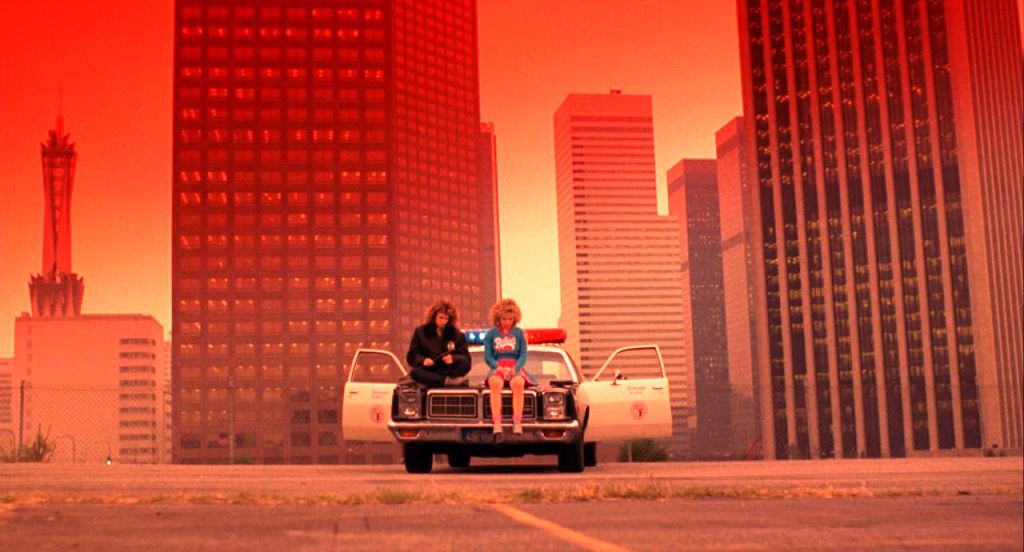
One of the most perfectly ‘80s genre films (the hair, the costumes, the Valley girls, the sets) is also a blast! Hardly surprising, considering that it was produced by Wayne Crawford, who brought the world the classic “Valley Girl” the year before.
It’s Christmastime in Los Angeles, which means it’s still sunny, but only in the 60s or 70s, and the literal tinsel is out in Tinsel Town. This year is special because a certain comet is passing by Earth for the first time since the dinosaurs disappeared. No one in LA could be bothered about that timing, so they throw on their biggest shoulder pads, hairspray their hair to three times the size of their heads, and go outside to gawk at the celestial spectacle.
Except for Regina (the beautiful 1980s starlet Catherine Mary Stewart) and her cheerleader sister Samantha (fun and funny Kelli Maroney). They were stuck inside all night and missed the viewing parties. Bummer, until they learn that the comet turned everyone else into piles of red dust except for a few who were partially exposed, who are now barely human zombies with a bad attitude. Thankfully these Valley girls not only have style, but they also have brains and a Green Beret father who taught them how to kick ass and handle an Uzi.
They are not totally alone. Hector (Robert Beltran) is a handsome truck driver who also escaped being turned into dust or a comet zombie. And unfortunately, there is also an organization of creepy scientists led by Dr. Carter (Geoffrey Lewis) who emerge from their underground doomsday facility in search of the untainted blood they need to keep from turning into dust themselves. Our heroines and Hector all have blood like that, and they all end up escaping from the facility, with two kids who were about to be drained. Rare (even when not in the middle of a comet apocalypse) LA rains come and wash away the dust, clear out the skies, and everyone (who is left) inherits the world and a bright future.
It’s everyone’s dream, and nightmare, to be the last person in the world. You can live anywhere and do anything. Choose the hottest and fastest car. Raid the malls. It all belongs to you. These sequences in “Night of the Comet” are fun. There are also genuinely eerie images of a deserted downtown Los Angeles bathed in a luridly colored haze (not the usual smog but comet debris) and a scary dream-within-a-dream sequence.
The look of the film, especially the radio station with its neon decorations and black leather Italian furniture, is so iconically of the era it could all be in a Patrick Nagel print. The cast is wonderful. You get a sese that they had a good time making the film. It’s nice to see Paul Bartel regulars Beltran and Mary Woronov (she plays the one scientist with a conscience) reteamed. The dialogue really sparkles in the same way that it would in “Heathers” a few years later. Stewart (always good) and Maroney (a perfect match) very quickly present a believable familiar relationship that helps to give importance to their characters’ wellbeing and survival.
Of note is the debt “Night of the Comet” obviously owes to the 1974 made for TV film “Where Have All the People Gone?” which deals with a family who survives while the rest of humanity have been turned into dust by a celestial phenomenon.
1. Robinson Crusoe on Mars (1964)
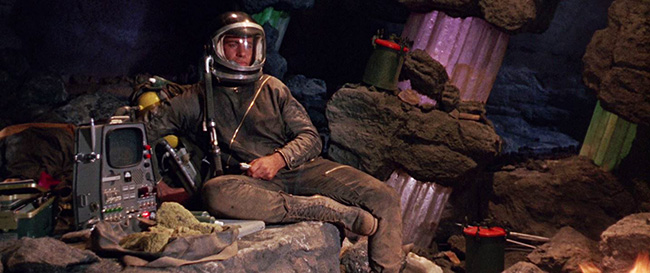
It’s difficult to take a film with a title like this seriously. And with decades of robotic exploration of Mars behind us, the science as presented is terribly outdated. The atmosphere is too thin and cold to endure without a spacesuit. The air is not breathable, even with periodic oxygen boosts. No plants have been found to grow there. No pools of liquid water stand ready for drinking and bathing. Yet, for its time, “Robinson Crusoe on Mars” was as accurate a description of Mars as scientific speculation allowed.
Commander Christopher Draper (Paul Mantee) and Col. Dan McReady (Adam West) are on a mission to Mars when a passing meteor pushes them too close to the planet and they have to evacuate. Draper survives but McReady does not. And now Draper is all alone on a world hostile to human life with only enough air and water to survive a few days. Against all odds he not only survives, but also thrives. He discovers he can heat and crush the Martian rocks for oxygen, and Mona (a monkey who also survived the crash) discovers an underground oasis where edible plants grow in a serene pool of vital water. He makes his home in a cave shot through with glowing crystalline structures, carves bowls from stone, and weaves new clothes.
Everything changes when aliens come (in the Martian warship models from “The War of the Worlds”) to mine the planet and one of their slaves escapes. Draper takes him in and names him Friday (Victor Lundin), a nod to the title and his own situation. Now they have to not only survive the planet but also the interstellar slavers who want their property back. It leads them on a journey across the planet, to a polar ice cap, and eventual rescue from Earth.
“Robinson Crusoe on Mars” was not a hit, and a planned sequel was never made. It never made Paul Mantee the star he perhaps should have been, despite generations of gay men who remember his completely unexpected, brief nudity while swimming in the cave pool (he had been a beefcake model years before making it in Hollywood). But it has finally earned some its due respect with a Criterion release. Director Byron Haskin had a background in special effects, and it shows. The film looks beautiful. Especially the aforementioned cave sets where Draper makes his home and takes recreation at the Martian pool, and the matte paintings. Stunning Martian vistas of red skies over beautiful barren deserts and frigid lakes against the ice caps. Those skies are a wonder, black and starry at top, and red near the horizon. Phobos and Deimos hovering there. It all owes a great deal to space artist Chesley Bonestell.
Towards the end both Draper and Friday begin a dialog about God. It’s almost a requirement in Science Fiction films from the era. With science and scientists so associated with Atheism and Atheism with Communism, it’s almost an inoculation against potential accusations that not only the planet, but perhaps the characters and filmmakers, as red.